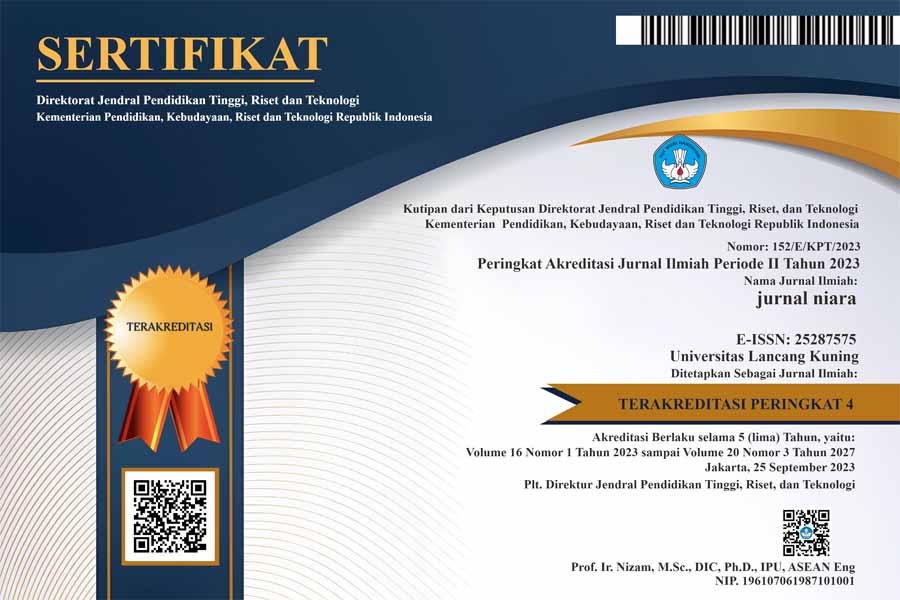Kebijakan Penentuan Pusat Pertumbuhan Industri Untuk Mendukung Pembangunan Daerah
Abstract
Penentuan pusat pertumbuhan ekonomi di suatu daerah merupakan topik yang perlu dikaji dan dipraktikkan untuk mendorong pembangunan ekonomi daerah. Pusat pertumbuhan, terintegrasi dengan sektor industri secara makro. Metode untuk menentukan pusat pertumbuhan industri meliputi: teknik analisis kebutuhan teknologi, analisis kesenjangan pencapaian dan target, penyusunan strategi untuk memenuhi kebutuhan dan pernyataan ketidakpastian yang akan datang. Hasil analisis menempatkan Bengkalis sebagai sentra produksi dan pertumbuhan industri di pesisir timur Riau bagian tengah. Kawasan Siak Kecil dan Bukit Batu menjadi pusat pertumbuhan industri untuk menunjang kegiatan di Dumai. Akses jalan dari kecamatan lain ke Buruk Bakul ditingkatkan untuk meningkatkan aksesibilitas. Pelabuhan di Buruk Bakul akan dibangun menjadi feeder port untuk pengiriman produk dari kawasan industri. Pusat pertumbuhan industri akan meningkatkan kualitas masyarakat lokal dan memastikan kondisi kehidupan yang berkelanjutan. Pengelompokan industri dapat meningkatkan pemanfaatan potensi pembangunan dan integrasi masyarakat lokal. Oleh karena itu, pusat pertumbuhan industri mendukung pengembangan modal sosial daerah dan kualitas hidup. Implementasi pusat-pusat pertumbuhan, melengkapi kesenjangan antara kebijakan pemerintah pusat dan provinsi serta masyarakat
Downloads
References
Derlukiewicz, N., Mempel-Śniezyk, A., Mankowska, D., Dyjakon, A., Minta, S., & Pilawka, T. (2020). How do clusters foster sustainable development? An analysis of EU policies. Sustainability (Switzerland), 12(4). https://doi.org/10.3390/su12041297
Gonzalez, A. V., Mack, E. A., & Flores, M. (2017). Industrial complexes in Mexico: implications for regional industrial policy based on related variety and smart specialization. Regional Studies, 51(4), 537–547. https://doi.org/10.1080/00343404.2015.1114174
Han, J. (2018). Integration and regional industrial development: Theoretical frameworks and literature reviews. Journal of China and International Relations, 6(1), 1–28. https://doi.org/10.5278/ojs.jcir.v6i1.2360
Harus, A. H., & Zhuravliov, O. V. (2015). Application of the Theory of “Growth Poles” to the Economic Development of Ukraine. Effective Economy, 8, 338.1. http://www.economy.nayka.com.ua/?op=1&z=4245
Hunter, R. J., & Saldana, G. (2013). The impact area of special economic zones: the effect of FDI on technology and knowledge transfer for native American reservations – a study of employment, innovation and absorptive capacity. Global Business and Economics Research Journal, 2(12), 1–28.
Jacob, J., & Hasan, N. (2016). Determining The Centers of Economic Growth And Regional Development Using Scalogram Analysis (An Empirical Study In West Halmahera Regency, Indonesia). IOSR Journal of Economics and Finance, 07(04), 31–36. https://doi.org/10.9790/5933-704033136
Karmyshev, Y. A. (2005). On potential sources of development of Russia’s Depressed Regions. Quality and FPI (CALS) Technologies, 1(1), 52–57.
Lapaeva, M., & Lapaev, S. (2020). Industrial Complex of the Orenburg Region: Challenges and Growth Prospects. 392(Eses 2019), 213–216. https://doi.org/10.2991/assehr.k.200113.043
Lu, M. (2017). Urban, regional and national development: the present and future of spatial political economics. China Economic Quarterly, 16(4), 1499–1532.
Lyashenko, A. Y. (2015). Definition of points of economic growth of industrial region on the example of Dnepropetrovsk region. Economic Bulletin Donbass, 3(41), 91–101.
Munyoka, W., & Maharaj, M. (2017). The effect of UTAUT2 moderator factors on citizens’ intention to adopt e-government: the case of two SADC countries. Problems and Perspectives in Management, 15(1), 115–123. https://doi.org/10.21511/ppm.15(1).2017.12
Nijkamp, P. (2016). The «resourceful region». A new conceptualisation of regional development strategies. Investigaciones Regionales, 2016(36Specialissue), 191–214.
Paramasatya, A., & Rudiarto, I. (2020). Implikasi penetapan wilayah pusat pertumbuhan industri terhadap penggunaan lahan di Kabupaten Majalengka. Jurnal Pembangunan Wilayah Dan Kota, 16(2), 144–157. https://doi.org/10.14710/pwk.v16i2.22257
Perroux, F. A. (1970). Note on the Concept of Growth Poles. In D. L. McKee, R. D. Dean, & W. H. Leahy (Eds.), Regional Economics: Theory and Practice (pp. 93–103). Free Press.
Pidgrushny, H. P. (2013). Importance of social-economic growth poles for the improvement of spatial social organization. Ukrainian Geographic Magazine, 4, 40–47.
Pinem, D. E. (2016). Menemukan strategi pengembangan kawasan industri melalui analisis sektor unggulan Kota Binjai. Jurnal Wilayah Dan Lingkungan, 4(1), 45–64. https://doi.org/10.14710/jwl.4.1.45-64
Pysar, N. (2017). Application of the methodology for determining the “growth poles” of the region’s industrial economy in the system of public administration. Problems and Perspectives in Management, 15(4), 72–85. https://doi.org/10.21511/ppm.15(4).2017.07
Qiu, R., Xu, W., & Zhang, J. (2015). The transformation of urban industrial land use: A quantitative method. Journal of Urban Management, 4(1), 40–52. https://doi.org/10.1016/j.jum.2015.07.001
Rahayu, S., Warsono, H., & Priyadi, B. P. (2019). Factors the Development of Region Promotion Activities Centre (PKWp) in Lebak District Banten Province. Jurnal Ilmiah Ilmu Administrasi Publik, 9(1), 111. https://doi.org/10.26858/jiap.v9i1.9352
Rianto, I. B., & Santoso, E. B. (2018). Penentuan lokasi kawasan industri tekstil terpadu di Kabupaten Majalengka. Jurnal Teknik ITS, 7(1), C19–C23. https://doi.org/10.12962/j23373539.v7i1.28970
Rozaki, Z. (2020). Decrease of agricultural land and industry growth in Special Region of Yogyakarta. IOP Conference Series: Earth and Environmental Science, 458(1). https://doi.org/10.1088/1755-1315/458/1/012033
Szewrański, S., Bochenkiewicz, M., Kachniarz, M., Kazak, J. K., Sylla, M., Świąder, M., & Tokarczyk-Dorociak, K. (2019). Location support system for energy clusters management at regional level. IOP Conference Series: Earth and Environmental Science, 354(1). https://doi.org/10.1088/1755-1315/354/1/012021
Yang, Z., Song, T., & Chahine, T. (2016). Spatial representations and policy implications of industrial co-agglomerations, a case study of Beijing. Habitat International, 55, 32–45. https://doi.org/10.1016/j.habitatint.2016.02.007















